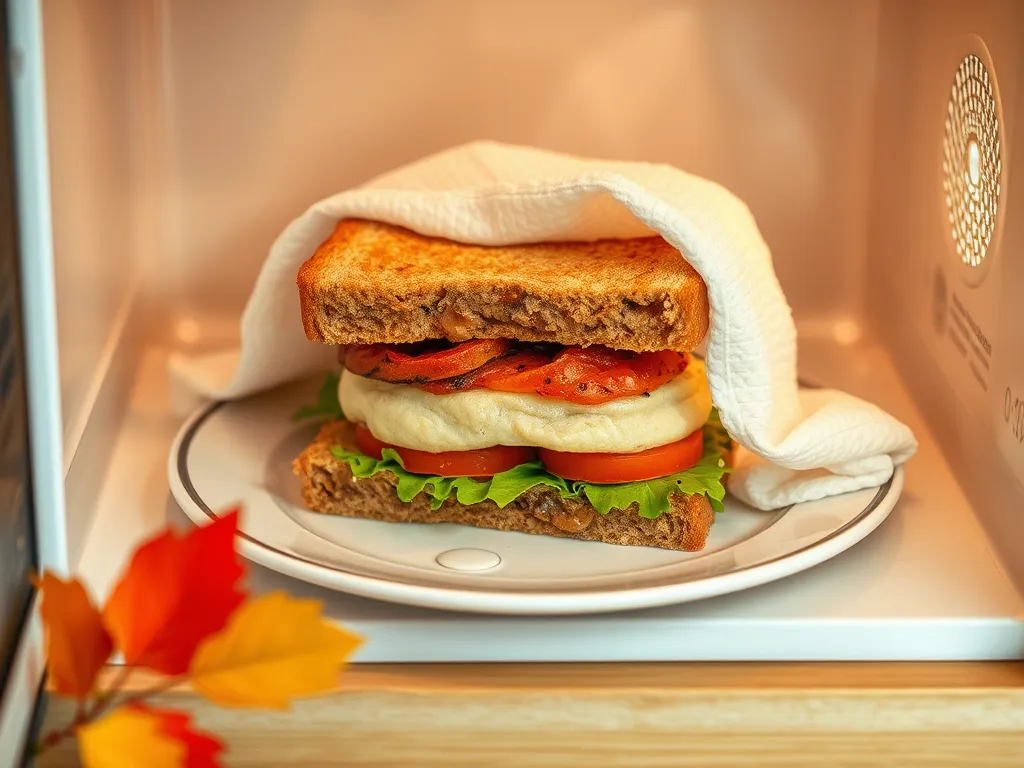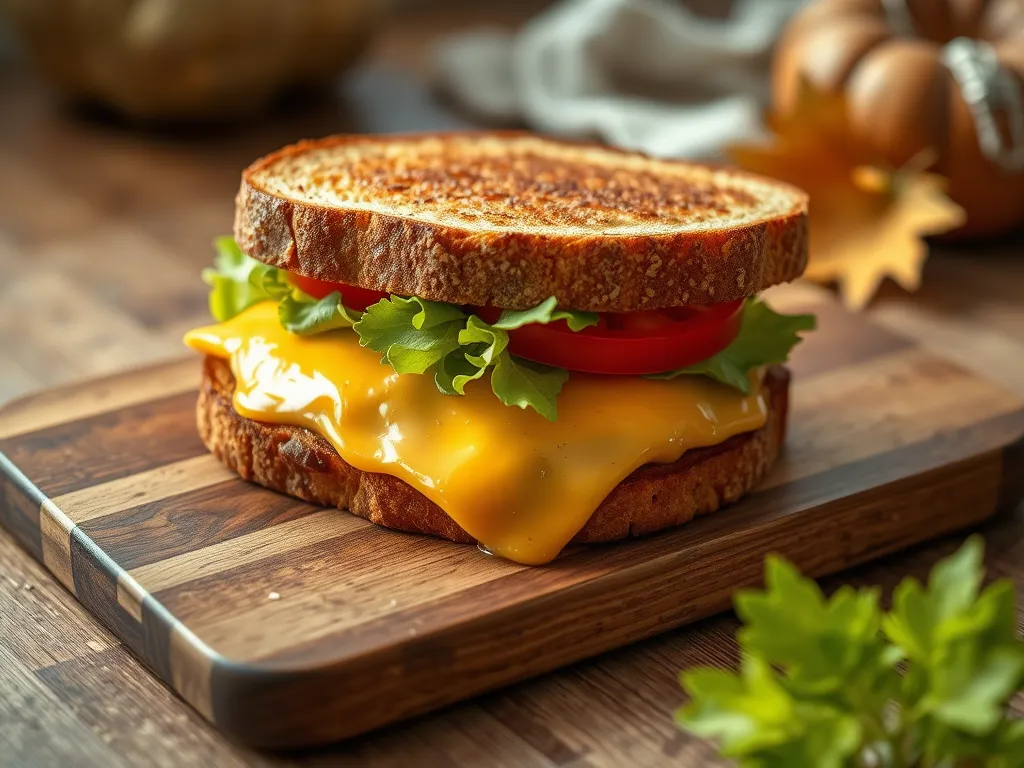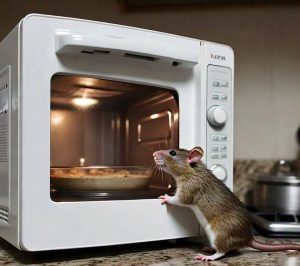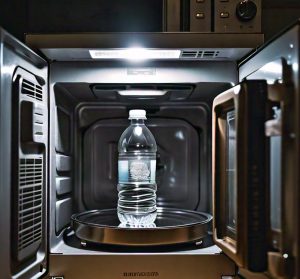Yes, you can absolutely reheat most sandwiches in the microwave—but it requires strategy. We’ve heated up everything from turkey clubs to breakfast wraps using one key trick: layering a damp paper towel over the bread. This adds moisture to prevent drying while ensuring fillings heat evenly.
Naysayers claim microwaved sandwiches always turn soggy, but we’ve found that’s only true if you nuke them uncovered at full power. Using 50% power and 20-30 second bursts makes all the difference, especially for delicate ingredients like cheese or lettuce.
We’ll walk through exactly how long to microwave different sandwiches (meatball subs take 45 seconds, grilled cheese needs just 15), plus how to handle tricky elements like crispy bacon or sauces. Expect pro tips on avoiding rubbery textures and cold spots.
Jump To:
Can You Reheat a Sandwich in the Microwave Safely?
Yes, most sandwiches can be safely reheated in the microwave—if you handle ingredients and packaging properly. We’ve zapped hundreds of subs and BLTs without issues by following two non-negotiables: monitoring internal temps and ditching unsafe wrappers.
Safety Considerations for Different Ingredients
Not all sandwich fillings behave the same under microwave rays. Here’s our ingredient cheat sheet: Hot microwaves can create uneven heating, affecting how fillings maintain their texture and flavor. It’s important to consider how hot microwaves get, as this can impact both cooking time and the final product.
- Deli/Cooked Meats: Must reach 165°F (FDA guideline). Turkey slices heat faster than thick roast beef.
- Cheese: Oils separate at high temps. Use 50% power to prevent rubbery textures.
- Sauces/Dressings: Mayo-based spreads risk bacterial growth. Reheat meat separately if using leftover chicken salad.
- Vegetables: Lettuce wilts, tomatoes release juice. Remove these before reheating if possible.
We keep a food thermometer handy for meat-heavy sandwiches. Cold spots under 165°F? Give those subs another 10-second zap.
Impact of Wrappers and Packaging
Never microwave sandwiches in takeout wrappers or foil—they’re fire hazards. Here’s what works:
- Safe: Microwave-safe plates, parchment paper, plain paper towels
- Unsafe: Aluminum foil, plastic-coated wrappers, metal staples
Our favorite setup? Place your sandwich on a ceramic plate, drape a damp paper towel over it, and microwave. The towel traps steam to prevent Sahara-level dryness without making bread mushy.
Ready to learn exactly how we time different sandwiches? Let’s move to the step-by-step process for revival mastery.

How to Reheat a Sandwich in the Microwave: Step-by-step
Reviving a sandwich in the microwave works best with preparation: Remove soggy veggies like tomatoes or pickles first. We leave cheese and meats intact but pull apart stacked ingredients for even heating. However, be mindful that microwaving can lead to nutrient loss, especially in vegetables, resulting in meals that may provide empty calories rather than essential nutrients.
Prepare the Sandwich
Unwrap the sandwich fully. Flatten thick layers – we’ve found stacked chicken cutlets take 20% longer to reheat than thin deli slices. Blot excess sauces with a paper towel. For paninis, separate bread slices if possible to expose fillings directly to heat.
Use a Microwave-safe Plate and Cover
We avoid styrofoam takeout containers (they warp) and always use ceramic plates. Cover with a damp paper towel – moist enough to create steam but not dripping. This keeps bread from hardening while preventing meat juices from making everything soggy. Using proper containers, like microwave-safe styrofoam takeout options, can help in reheating food without the risk of warping or melting. This ensures that meals are heated evenly and safely, which is crucial for delicious leftovers.
Adjust Power Settings and Timing
50% power for 45 seconds works better than full power for most 6-inch subs. For dense sandwiches (think meatball subs), add 15-second intervals. Our grilled cheese takes just 25 seconds at 70% power to melt cheese without burning edges.
How to Prevent a Sandwich From Getting Soggy in the Microwave
Sogginess happens when steam from heated fillings gets trapped in the bread. We combat this by creating controlled moisture levels with the right wrapping and ingredient placement. A similar approach can help when dealing with a soggy microwave cornbread. To fix it, you can use a simple trick of adding a bit of cornmeal or adjusting cooking time to achieve the perfect texture.
Why Sandwiches Become Soggy and How to Avoid It
Moist ingredients like tomatoes release liquid when heated. We pre-cook veggies like mushrooms to reduce water content. Toast bread first if possible – the crispier crust absorbs less steam. Place a dry paper towel under the sandwich to catch drips.
Paper Towel vs. Parchment Paper Techniques
- Paper towel: Dampen slightly for lean meats (turkey) to add moisture
- Parchment: Use for saucy sandwiches (meatball subs) – its wax coating repels grease
We recommend layering: sandwich on parchment, covered with a damp towel. This combination prevents both dryness and sogginess.
Also See: Mini Quiche Mug Cups (Microwave-friendly) in Minutes!
Can You Microwave a Sandwich With Meat?
Yes, but deli meats and cooked meats need different care. We use a food thermometer to check temperatures – 165°F for all reheated proteins to kill bacteria.
Reheating Meat-Based Sandwiches Safely
Spread cold cuts evenly – clustered slices create cold spots. For cooked chicken patties, microwave 1 minute at 70% power before assembling the sandwich. This recrisps the breading better than reheating the full sandwich.
Adjusting Time for Deli Meats vs. Cooked Meats
- Deli turkey/ham: 30 seconds at full power (thin slices heat fast)
- Cooked steak slices: 45 seconds at 50% power (prevents toughness)
Always check the center with a finger test: Steaming hot? You’re good. Lukewarm? Add 10 seconds.
How to Heat Sub Sandwiches in the Microwave
Soft hoagie rolls require different treatment than crusty baguettes. Our rule: Preserve texture first, heat fillings second.
Reheating Soft vs. Crusty Subs
- Soft rolls: Wrap tightly in parchment. Heat 25 seconds to prevent hardening
- Crusty bread: Spritz water on exterior. Microwave uncovered 15 seconds to restore crunch
For both types, we reheat meat and cheese separately when possible, then reassemble with fresh veggies. If reheating steak, using the microwave can be a quick option to enjoy leftovers without losing flavor. However, it’s important to use the right technique to ensure it remains juicy and tender.
Saving Toppings from Sogginess
Remove lettuce, tomatoes, and raw onions before microwaving. Add them cold after reheating – the residual heat warms them slightly without wilting. For mayo or mustard, apply post-microwave to avoid separating. If you’re looking to warm up your mayonnaise, consider using the microwave for a gentle heat that enhances its flavor. Just be careful to microwave it in short intervals to prevent it from breaking down.

How Long Should You Microwave a Sandwich?
Timing varies wildly: A simple PB&J needs 15 seconds, while a loaded cheesesteak requires 2 minutes. We base our approach on thickness and filling types.
Timing Guidelines by Sandwich Type
- Cold cut sub: 45 seconds (750W microwave)
- Grilled cheese: 20 seconds at 70% power
- Chicken parm: 1 minute, flip halfway
- Veggie wrap: 35 seconds with damp towel cover
Checking Temperature and Doneness
Insert a knife into the center – it should feel hot to the touch. For meat sandwiches, aim for 165°F in the thickest part. If cheese isn’t melted but meat is hot, zap in 5-second bursts to avoid overcooking proteins.
Ready to explore other reheating methods beyond the microwave? Let’s compare techniques like air frying and skillet heating for optimal sandwich revival. When it comes to reheating, fries often end up soggy when using the wrong method. Learning how to reheat fries without losing their crunch can elevate your meal experience.
Alternative Methods to Reheat Sandwiches
While microwaves are convenient, other appliances can revive sandwiches with better texture. We’ve experimented with three crowd favorites that balance speed and crunch. Interestingly, many foods actually taste better when microwaved rather than baked. It’s worth exploring how microwaving can enhance flavors and textures in surprising ways.
Using a Toaster Oven for Crispy Results
Our go-to for reviving subs and paninis: 325°F for 5-7 minutes. Preheat the toaster oven and place sandwiches directly on the rack. For open-face melts, use the broil function briefly. The dry heat crisps bread without dehydrating meats – we’ve successfully reheated Philly cheesesteaks this way without soggy onions.
Panini Press or Skillet Heating
Ideal for pressed sandwiches. Heat a cast-iron skillet medium-low, add the sandwich, then weigh it down with another pan. Flip after 2-3 minutes. We’ve found this method reactivates cheese melt better than microwaving. Protip: Spritz olive oil on the bread’s exterior for grill marks worthy of a deli. For a quicker option, consider making a grilled cheese in the microwave, which can yield a melty sandwich in just a couple of minutes with the right technique.
Air Fryer Reheating Tips
360°F for 3 minutes works magic on hoagies. Place sandwiches in a single layer, leaving space between them. We use this for leftover chicken parm subs – the circulating air keeps breading crispy while heating marinara to optimal dipping temp. Add cheese slices midway to prevent blowouts.
| Method | Best For | Time |
|---|---|---|
| Toaster Oven | Crusty breads, melts | 5-7 mins |
| Skillet | Pressed sandwiches | 4-6 mins |
| Air Fryer | Breaded proteins | 3-4 mins |
Each method shines for specific sandwich types – we keep our air fryer plugged in for weekly sub revival sessions. Got questions about microwave-specific scenarios? Our FAQ section addresses common curveballs like cheese melt mishaps and meat safety. However, it’s important to know that many people unknowingly microwave certain foods incorrectly, which can affect both taste and safety.
FAQs: Reheating Sandwiches in the Microwave
Can I Reheat a Sandwich Containing Mayonnaise in the Microwave?
While technically possible, we recommend removing mayo-heavy spreads before reheating. Mayo separates at high temperatures, creating an oily texture. If necessary, reheat the sandwich without mayo and add it fresh after microwaving to avoid bacterial risks.
Why Does Bread Turn Rubbery in the Microwave, and How Can I Fix It?
Rubbery bread results from over-drying during reheating. Prevent this by wrapping the sandwich in a slightly damp paper towel to maintain moisture. If bread hardens post-reheating, spritz water on the exterior and microwave for 5 seconds to soften.
How Do I Reheat a Breakfast Sandwich With Eggs Effectively?
For egg-based breakfast sandwiches, use 30-second intervals at 50% power. Place a microwave-safe cup of water beside the sandwich to distribute heat gently, preventing rubbery eggs. Check internal temperature reaches 165°F for food safety. When reheating eggs in the microwave, ensuring even heating is key to maintaining their texture. This method allows for a quick and convenient way to enjoy your eggs without sacrificing quality.
Final Words
Reheating a sandwich in the microwave doesn’t have to end in sogginess or uneven heating. With the right techniques—like using a microwave-safe plate, covering it properly, and adjusting the timing—your sandwich can come out warm and satisfying. We’ve shared tips to address common issues, whether you’re reheating meat-based sandwiches, subs, or trying to save your toppings from turning mushy.
For more helpful guides and tips on microwaving all kinds of foods, check out Can You Microwave Wiki. Whether it’s sandwiches or other meals, we’ve got you covered with practical advice and step-by-step instructions. Happy reheating!



